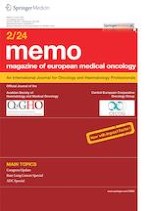Published in:

Open Access
18-12-2023 | Nonseminoma | short review
Diagnosis and management of mediastinal extragonadal germ cell tumors
Authors:
Prof. Dr. med. Axel Heidenreich, Pia Paffenholz, David Pfister
Published in:
memo - Magazine of European Medical Oncology
|
Issue 2/2024
Login to get access
Summary
Extragonadal germ cell tumors (EGCT) are rare and comprise only 2–3% of all testicular germ cell tumors. The majority of EGCT are located in the mediastinum, followed by the retroperitoneum. Although histologically similar to germ cell tumors (GCT), EGCT have distinct histological patterns which result in a biologically aggressive variant of GCT with the need for interdisciplinary care in highly specialized centers. The majority of mediastinal EGCT harbor teratoma or yolk sac tumor elements. Treatment usually consists of a combination of systemic cytotoxic therapy and aggressive postchemotherapeutic surgery. First-line treatment for extragonadal seminomas and nonseminomas consists of three and four cycles of PEB or PEI, respectively. In patients with significantly elevated markers, a personalized approach based on adequate marker decline can be used, and in poor-risk patients, first-line high-dose chemotherapy might be discussed. Postchemotherapeutic surgery remains an integral part of the multidisciplinary treatment for nonseminomatous EGCT and it is of utmost importance that all residual masses, independent of size and location, are resected completely. Residual masses in seminomatous EGCTs rarely harbor vital cancer and might be followed by serial imaging studies or FDG-PET/CT. The prognosis of nonseminomatous EGCT is poor, with 5‑year overall survival rates of 17%, 60–70%, and 90% for poor, intermediate, and excellent prognosis, respectively. Prognosis for seminomatous EGCT is excellent, with 5‑year overall survival rates of 95% and 88% for good and intermediate prognosis, respectively. Salvage chemotherapy consists of high-dose chemotherapy or targeted therapy in very selected patients.